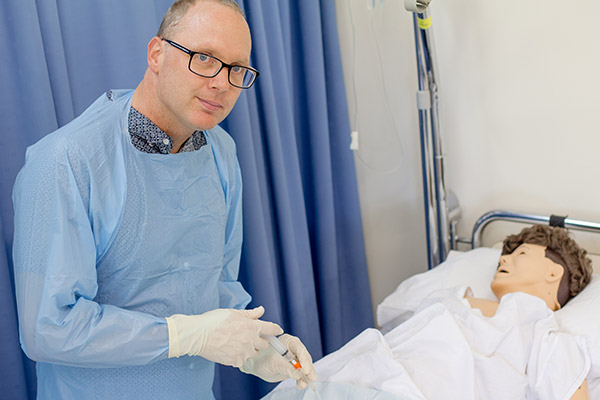Antiseptic key to reducing one the most common healthcare associated infections
The evidence has been inconclusive until now: using an antiseptic instead of saline when inserting catheters reduces the risk of urinary tract infection.
The findings, published today in the journal Lancet Infectious Disease, will inform clinical practice worldwide, says chief investigator Professor Brett Mitchell from the School of Nursing at Avondale College of Higher Education. “They will hopefully reduce the burden of urinary tract infections for thousands of patients.”
Mitchell and his team’s 32-week stepped-wedge randomised controlled trial measured a 94 per cent reduction in the risk of urinary tract infection at three Australian hospitals when the hospitals used chlorhexidine as part of urinary catheter insertion practices.
“This suggests a significant decrease in the rate of urinary tract infection in the seven days following catheter insertion,” says Mitchell. The simplicity of the intervention is also significant because “the use of chlorhexidine can be easily implemented in hospitals.”
There have been other studies [about preventing catheter-associated urinary tract infections], but they either didn’t get enough participants or didn’t design with enough rigour to make strong conclusions. This trial has both: plenty of participants and a good design.Professor Brett Mitchell, Director, Lifestyle Research Centre, Avondale College of Higher EducationThe nursing implications are considerable, says co-author and registered nurse Dr Anne Gardner, at the time of the study an adjunct professor from the School of Public Health and Social Work at Queensland University of Technology. “Nurses are justifiably reluctant to use antiseptics without good evidence of their efficacy,” but the trial “will help in clinical decision-making.”
As Gardner notes, the findings need to be replicated in other studies but “go some way to providing a definite answer about whether there is any advantage in using chlorhexidine over normal saline when cleaning the meatal area before urinary catheter insertion.”
The design of the trial introduced the intervention slowly across different hospitals, effectively ensuring each hospital acted as its own control. Allen Cheng, also a co-author and Professor of Infectious Diseases Epidemiology in the School of Public Health and Preventive Medicine at Monash University, notes researchers are increasingly using this type of study to test more complex infection prevention interventions.
More research to evaluate the cost-effectiveness of using chlorhexidine is in progress. According to Mitchell, the interim results indicate the antiseptic is not only cost-effective but potentially cost-saving.
International guidelines differ in their recommendations about the choice of agent for meatal cleaning. The United Kingdom’s epic3 guidelines for preventing healthcare-associated infections in National Health Service hospitals, for example, recommends the use of saline. While the United States Healthcare Infection Control Practices Advisory Committee provides no recommendation, stating instead that the issue remains unresolved and calling for more research on the use of antiseptic solutions.
This lack of cohesiveness—stemming from a lack of rigorously designed trials and conclusive evidence—means clinical practice varies and is probably not best practice.
Mitchell believes the stepped-wedge randomised controlled trial—the first to conclusively study chlorhexidine and the prevention of catheter-associated urinary tract infection—heeds the call for good evidence. “There have been other studies, but they either didn’t get enough participants or didn’t design with enough rigour to make strong conclusions. This trial has both: plenty of participants and a good design.”
Urinary tract infections are one of the most common infections patient acquire in hospital, with previous research indicating about 71,000 urinary tract infections occurring in Australia each year. These infections are often associated with the use of urinary catheters.
Grants from HCF Foundation and from the Lifestyle Research Centre at Avondale funded the study. “I’m very grateful for the support of HCF Foundation as well as those who donate money to support research at Avondale,” says Mitchell. “Without these funds, this study and its findings would not have been possible.”
Share

